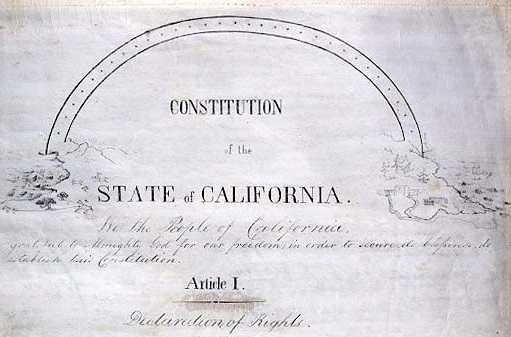
Why Are Folks Talking About the Gann Limit or the State Appropriations Limit?
The Constitution requires the state to divide excess revenues between rebates to taxpayers and additional spending on schools
By Chris Micheli, February 17, 2022 9:11 am
In the past few years, but particularly this year, lots of people in and around the Capitol are talking about the “Gann Limit” or the “State Appropriations Limit,” often referred to as “SAL.” So, what is the SAL or the Gann Limit? Basically, if the state has revenues above the SAL over two consecutive years, the Constitution requires the state to divide the excess revenues between rebates to taxpayers and additional spending on schools.
The SAL or Gann Limit was enacted by the voters in November 1979 as Proposition 4, just one year after voters adopted Proposition 13 and their continued interest in limiting state and local government spending. Basically, Prop. 4 capped spending at 1978-79 levels, which are adjusted annually based upon changes in population and cost-of-living.
While most state appropriations are subject to the SAL, there are certain types of appropriations that are exempt from the SAL, such as capital outlay, local government subventions, and debt service.
Constitutional Provisions
The SAL is in Article XIII B of the State Constitution. The appropriations limit is calculated pursuant to Government Code Section 7902. Although originally adopted in 1979, the constitutional provisions were amended in June 1990 by the voters in Prop. 111. As amended by Prop. 111, the appropriations limit of each entity of government is now the appropriations limit for the 1986–87 fiscal year, with adjustments annually for changes in population and inflation.
Article 13B Section 1 provides that the total annual appropriations subject to limitation of the State and of each local government cannot exceed the appropriations limit of the entity of government for the prior year adjusted for the change in the cost of living and the change in population, except as otherwise provided.
Section 2 provides that fifty percent of all revenues received by the State in a fiscal year and in the fiscal year immediately following it in excess of the amount which may be appropriated by the State in compliance during that fiscal year and the fiscal year immediately following it shall be transferred and allocated to education funding, and fifty percent “shall be returned by a revision of tax rates or fee schedules within the next two subsequent fiscal years.”
Section 3 requires the appropriations limit for any fiscal year to be adjusted in specifies instances, including in the event that the financial responsibility of providing services is transferred, in whole or in part, from one entity of government to another or from an entity of government to a private entity, or in the event an emergency is declared by the legislative body of an entity of government, or in the event an emergency is declared by the Governor.
Section 5 provides each entity of government may establish contingency, emergency, unemployment, reserve, retirement, sinking fund, trust, or similar funds as it deems reasonable and proper. Contributions to any fund, to the extent that such contributions are derived from the proceeds of taxes, constitute appropriations subject to limitation in the year of contribution. Neither withdrawals from any such fund, nor expenditures of (or authorizations to expend) such withdrawals, nor transfers between or among such funds, constitute appropriations subject to limitation.
Section 9 specifies that “appropriations subject to limitation” for each entity of government do not include:
- Appropriations for debt service.
- Appropriations required to comply with mandates of the courts or the federal government which, without discretion, require an expenditure for additional services or which unavoidably make the provision of existing services more costly.
- Appropriations of any special district which existed on January 1, 1978, and which did not as of the 1977–78 fiscal year levy an ad valorem tax on property in excess of 121/2 cents per $100 of assessed value; or the appropriations of any special district then existing or thereafter created by a vote of the people, which is totally funded by other than the proceeds of taxes.
- Appropriations for all qualified capital outlay projects, as defined by the Legislature.
- Appropriations of revenue which are derived from that portion of the taxes imposed on motor vehicle fuels for use in motor vehicles upon public streets and highways at a rate of more than $0.09 per gallon, sales and use taxes collected on tax increment, and that portion of the weight fee imposed on commercial vehicles which exceeds the weight fee imposed on those vehicles on January 1, 1990.
Section 12 excludes from the “appropriations subject to limitation” definition appropriations of revenue from the tobacco tax from 1988. Section 13 excludes from that definition appropriations of revenue from the California Children and Families First Act of 1998. Section 14 excludes from that definition from the 2016 tobacco tax. Section 15 excludes from that definition revenue from the Road Maintenance and Rehabilitation Account created by the Road Repair and Accountability Act of 2017.
Statutory Provisions
There are also provisions related to the SAL in the Government Code, Title 1, Division 9 (“Expenditure Limitations”), in Section 7900 – 7914. Division 9 was added in 1980 by Chapter 1205. Selected provisions of Division 9 include the following:
Section 7900 makes two legislative findings and declarations, that the purpose of Division 9 is to provide for the effective and efficient implementation of Article XIII B of the California Constitution, and that citizens be provided with timely information so that effective oversight can be accomplished at the local level.
Section 7901 defines the terms “change in California per capita personal income” and “change in population” for a local agency, a school district, and a community college district for purposes of Article XIII B. It also defines the terms “local agency,” “school district,” “local jurisdiction,” “revenues,” and “proceeds of taxes.”
Section 7909 requires the Department of Finance, no later than May 1 of each year, to notify each local agency of the change in the cost of living or change in California per capita personal income, whichever is less, and population for each local agency for the prior calendar year.
Section 7910 requires the governing body of each local jurisdiction to annually, by resolution, establish its appropriations limit and make other necessary determinations for the following fiscal year pursuant to Article XIII B of the California Constitution at a regularly scheduled meeting or noticed special meeting.
Section 7911 authorizes a local jurisdiction to return excess revenues by granting a tax credit or refund, by providing a temporary suspension of tax rates or fee schedules, or by any other means consistent with the intent of that section. The determination by the governing body of such entity of the means by which such excess revenues are to be returned is a legislative act.
Section 7912 requires the Governor to annually include in the budget as submitted to the Legislature an estimate of the state’s appropriations limit for the budget year. This estimate is subject to the budget process and is established in the Budget Bill.
Section 7914 defines an appropriation for a “qualified capital outlay project” to mean an appropriation for a fixed asset (including land and construction) with a useful life of 10 or more years and a value which equals or exceeds $100,000.
Practical Implications
What does this mean? Basically, according to the Legislative Analyst’s Office, “the state either would need to reduce taxes or issue refunds to taxpayers and make additional payments to schools” in the amounts in excess of the SAL. “Further, without significant budget changes, the state likely does not have the capacity for new services or program expansions.”
The “room” under the SAL has been reduced because there has been tremendous growth in personal income tax revenues in this state and Prop. 98-required spending on schools has also grown more quickly than limits. The LAO has previously set forth several options for the Legislature to consider: Take no action, which means issuing tax refunds and allocating excess revenues to schools; Increase spending on excluded items; Reduce taxes (so there are not excess revenues) and spending (on exempt purposes, such as local fiscal relief and infrastructure); Make statutory changes to the SAL; Go to the voters and make constitutional changes to the SAL.
Because of the very large recent growth in revenues above the Governor’s January 10 budget projections, addressing the SAL or Gann Limit will likely be an important discussion item in this year’s state budget negotiations. Be aware that, because there are two years to determine by how much the SAL has been exceed, if revenues are estimated to drop the following year, the entire excess amount to schools and taxpayers might not get distributed.
- Legislative Policy on Bay Area Pilotage - July 26, 2025
- Small Craft Harbors and Waterways in California - July 25, 2025
- Disability of Parties in Civil Actions - July 24, 2025








Me thinks that all of the sudden there will be a Revenue drop next year,because the last they want is to give us money back.